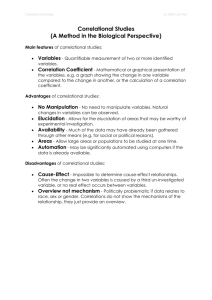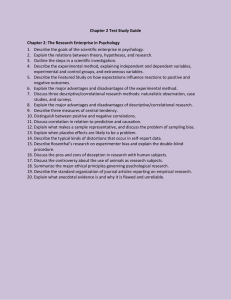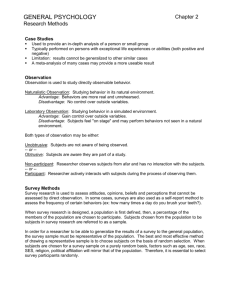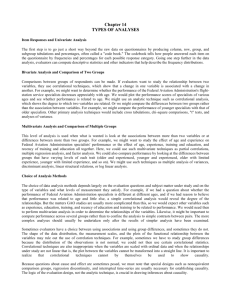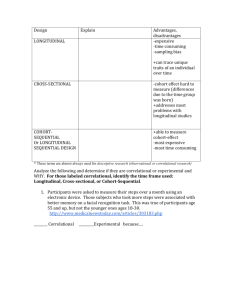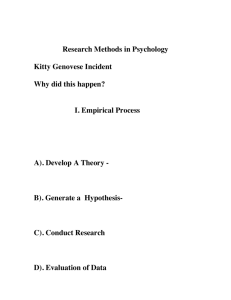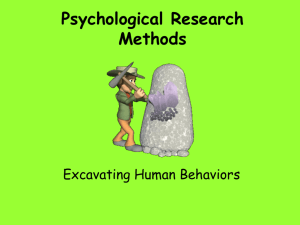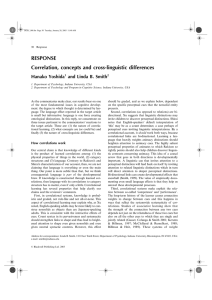Science: Ways of Knowing
advertisement
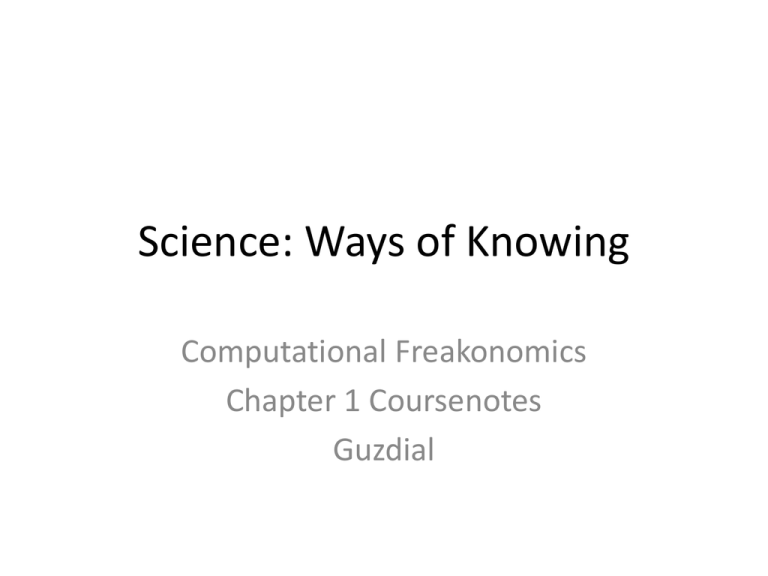
Science: Ways of Knowing Computational Freakonomics Chapter 1 Coursenotes Guzdial Poll • What’s your favorite ice cream? 1. 2. 3. 4. Vanilla Chunky Monkey Cherry Garcia Extreme Moose Tracks What was wrong with that poll? • Can I make a claim about what ice cream that GT undergraduate students like? How do we decide to believe something? • • • • Tenacity Authority Reason Common Sense The incumbent usually wins elections. • Which forms of reasoning are people using? 1. 2. 3. 4. Tenacity Authority Reason Common Sense General methods of science 1. Dispassionately observe by means of our sense, 2. Using reason to compare various theoretical conceptualizations based on experience. • Real scientists don’t really use the “Scientific Method.” (Nancy Nerssessian) – They build models • Good science is replicable and falsifiable. Naturalistic Observation • If you don’t know much, watch it and characterize it. • Big questions: – Get involved or not? – How be dispassionate – How be falsifiable • Examples: – Barbara McClintock in Biology – Design-based research in Education Correlational Approach • If one event occurs, does the other one, too? • Examples: – Smoking and lung cancer – 1854 Cholera outbreak, John Snow Problems of correlational approach • What if multiple variables? – South African President Thabo Mbeki's embrace of AIDS-denialist claims: The resulting governmental refusal to provide effective anti-HIV treatment in South Africa has been blamed for hundreds of thousands of premature AIDS-related deaths in South Africa. • What if non-linear? Internal validity • Do we believe it? • Ecological validity – In vitro vs. In vivo Experiment: Relaxation techniques • Gymnastics team wants to improve their mental game. • Teach relaxation techniques. – If scores go up after the relaxation techniques, did it work? Experimental Method • Treatment/experimental group vs. Comparison/control group • Operational definitions: What are you going to measure? • Beware the Hawthorne Effect. – Taxicab drivers, rear lights, front end vs. back end experiments – Ann Brown and “feeling special” Time series design • Within-subjects design – Pre and post testing • Between-subjects design – Compare two different groups • Time series design: Within-subjects design – That’s what our gymnastics experiment is • Interrupted time series design: Multiple tests before or after – Check multiple meets before and multiple after. – Was the change “lasting”? – Variance? Multiple time series design • Do before/after, but between different subjects or populations. • Does having a bottle deposit impact litter? – You could before/after, but maybe that state is special? – Compare two states at the same times. – New York (with deposit): 260 items of litter -> 145. – New Jersey (no deposit): 221 -> 214 • Alternative explanations? Assumptions? Classify the Experiment • Looking at student grades, before a suspect teacher, with a suspect teacher, after a suspect teacher. 1. Correlational design 2. Naturalistic observation 3. Multiple time series design 4. Interrupted time series design Classify the Experiment • Look at Sumo wrestlers, A vs. B, when A is 6-8 and B is 7-7, and other times that A vs. B. 1. Interrupted time series design 2. Between-subjects design 3. Multiple time series design 4. Correlational design Retrospective Design • You know the end result. • You split the participant pool based on end result. • You go back in time, to gather data to compare two groups. • Example: High school activities => Schizophrenia Correlational Design • Collect information between two variables. • Does one vary at the same time (same amounts) as the other? • Assumptions: – Third variable? – Non-linear? • Can “control” for variables. Key issue: Correlation does not imply causation • Skirt length and stock prices are highly correlated. • Student performance goes up in smaller classes. Operational Definition • You can’t always measure the thing you want. • So you measure something that you believe represents the same thing. • May not always be true. – Knowledge and grades. – Research quality and research funding. – We want to tax the wealthier more than the poor, so we tax their paychecks. • What might we tax instead? Classify the Experiment • Running increases lifespan. Track thousands of people. Claim: Running 1.5-2 hours total/week for 2-3 sessions adds 6.2 years to men’s life, 5.6 years to women’s life. • What kind of experiment is this? 1. Correlational design 2. Retrospective design 3. Multiple time series design 4. Interrupted time series design Classify the Experiment • We’ve got two different instructional techniques. Which one is better? Two groups get the two treatments. We measure performance on a task after the treatment, then wait one week, and check performance again. 1. Correlational design 2. Interrupted time series design 3. Multiple time series design 4. Retrospective design Give me advice! • GaComputes: $3.5M investment over 5 years, starting in 2006. • One goal: Increase number and diversity of students taking Advanced Placement CS. • How would you know if it worked? What kind of experiment would you run?

